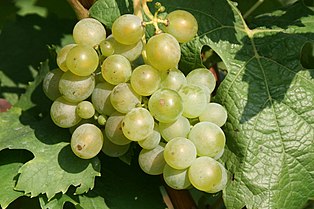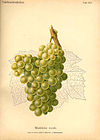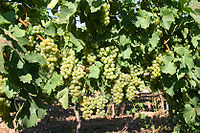Müller-Thurgau
| Müller-Thurgau | |
|---|---|
| Synonyms | Rivaner - for more see the Synonyms section |
| Breeding number | 58 |

|
|
| Art | Grape vine ( Vitis vinifera subsp. Vinifera ) |
| Berry color | yellowish green |
| use | |
| origin | Germany, Switzerland |
| breeder | Hermann Müller , Geisenheim Research Station in the Rheingau |
| Breeding year | 1882 |
| VIVC no. | 8141 |
| ancestry | |
|
Cross of |
|
| List of grape varieties | |
Müller-Thurgau is a white wine variety that is now also called Rivaner for legal and marketing reasons . It was bred in 1882 by the Swiss Hermann Müller-Thurgau from the Swiss canton of Thurgau at the Geisenheim research institute in the Rheingau . With 22,934 hectares (2010) of cultivation area, Müller-Thurgau is the world's most successful new white wine variety . One example of the original vine has been preserved in Wädenswil.
ancestry
The variety is a cross between Riesling and Madeleine Royale by Hermann Müller .
History of origin
From 1882, Hermann Müller carried out cross-breeding attempts at the Geisenheim research institute . The preliminary examination of the new breeds lasted until 1890. In 1891 Müller moved to Wädenswil (Switzerland) and 150 cuttings from the Geisenheim new breeds were sent to Switzerland. The cuttings were grown in Switzerland from 1892 to 1893. In 1894, 73 varieties could be planted outdoors. The Riesling × Silvaner had breeding no. 58. Propagation with cuttings by Heinrich Schellenberg (Eidgenössische Forschungsanstalt Wädenswil) took place in 1897.
The first refinement on rootstocks took place in 1901 and in 1903 the first harvesting systems of the new variety were created. From 1906 to 1907, the test facility consisted of 894 refined Riesling × Silvaner on seven rootstocks. In 1908, 22,000 grafted vines were distributed in Switzerland and abroad. The first return of 100 vines to Germany took place in 1913 by Dern using the variety designation Müller-Thurgau-Rebe.
In the 1930s, test facilities were set up in all German wine-growing regions and selections were made by Hartmut Fueß . The cultivation results were seen in 1938 at a Müller-Thurgau conference in Alzey . Since 1945, the variety has been increasingly planted during reconstruction and conversion. The seed law entry took place in 1956. From 1969 Müller-Thurgau is entered in the list of varieties according to the Seed Traffic Act. The classification as a recommended variety in all wine-growing regions in Germany took place in 1970. The Müller-Thurgau penetrated in Germany to the first place in terms of cultivation area until 1975. Propagation as clones of the Müller-Thurgau variety, basic and certified seedlings , took place from 1980.
Clarification of the crossing partners
Hermann Müller himself, however, was not entirely sure which parent grape varieties he had actually used. That's why there were doubts from the start. Attempts to reproduce the breeding failed. For a long time it was assumed that it was a cross between Riesling and itself.
In 1957, Heinz-Martin Eichelsbacher (born December 29, 1924 in Munich; † September 3, 2003 in Würzburg) was able to prove the absence of Silvaner genetic material during his doctorate at the Bavarian State Institute for Viticulture and Horticulture in Veitshöchheim (Franconia).
Again in 1998 in the Klosterneuburg Viticulture School in Austria, with the help of genetic engineering (using specific microsatellites ), the Silvaner was excluded from being a cross-breeding partner. The result suggested Chasselas as a crossbreed partner (father candidate). Scientists from the German Federal Institute for Breeding Research in Siebeldingen / Palatinate were then able to determine the origin of the Müller-Thurgau grape even more precisely in 1999 with new, expanded genetic diagnosis options: They identified the Madeleine Royale grape variety as the father. Madeleine Royale was seen as a breed from the Chasselas (Gutedel) shape , but has been considered a cross between Pinot and Trollinger since an investigation in 2009 .
progeny
| Variety name | Crossing partner |
| Albalonga | Rieslaner × Silvaner |
| Arnsburger | Riesling CL. 88 Gm × Riesling CL. 64 gm |
| Bacchus | (Silvaner × Riesling) × Müller Thurgau |
| Boschidar | Rieslaner × Müller Thurgau |
| Cumdeo blanc | Gewürztraminer × Müller Thurgau |
| Diana | Silvaner × Müller Thurgau |
| Elegancia | (Traminer × Elbling) × Müller Thurgau |
| Ezmet / A | Ezerjó × Müller Thurgau |
| Faber (grape variety) | White Burgundy × Müller Thurgau |
| Floriánka | Veltliner early red × Müller Thurgau |
| Fontanara | Rieslaner × Müller Thurgau |
| Freiburg 90-64 | Müller Thurgau × FREIBURG 587-54 |
| Freiburg 986-60 | SV 12-481 × Müller Thurgau |
| Garnier 15-6 | SV 18-315 × Müller Thurgau |
| Geilweilerhof 30N- 9- 35 | Silvaner × Müller Thurgau |
| Geilweilerhof 30N- 9- 83 | Silvaner × Müller Thurgau |
| Geilweilerhof 30N- 9-129 | Silvaner × Müller Thurgau |
| Geilweilerhof 31- 1-118 | Silvaner × Müller Thurgau |
| Geilweilerhof B- 8-20 | Oberlin 702 OP × Müller Thurgau |
| Geilweilerhof KOE- 50-24 | (Silvaner × Müller Thurgau) Müller Thurgau |
| Geilweilerhof KOE- 50-100 | (Silvaner × Müller Thurgau) × Müller Thurgau |
| Geisenheim 17-59 | Chasselas Napoleon × Müller Thurgau |
| Geisenheim 17-103 | Müller Thurgau × Pirovano 1 |
| Geisenheim 18-1 | Müller Thurgau × admirable de Courtillier |
| Geisenheim 18-26 | Müller Thurgau × admirable de Courtillier |
| Geisenheim 18- 54 | Müller Thurgau × (Madeleine Angevine × Calabreser Fröhlich) |
| Geisenheim 18-58 | Müller Thurgau × (Madeleine Angevine × Calabreser Fröhlich) |
| Geisenheim 18-62 | Müller Thurgau × (Madeleine Angevine × Calabreser Fröhlich) |
| Geisenheim 18-91 | Müller Thurgau × (Madeleine Angevine × Calabreser Fröhlich) |
| Geisenheim 6437 | Müller Thurgau × (Wälsche Early Blue × Färber 1) |
| Geisenheim 6441-4 | (Seibel 7053 × Riesling) × Müller Thurgau |
| Geisenheim 7213 | Kolor × Müller Thurgau |
| Geisenheim 7221 | Opaque red × Müller Thurgau |
| Gloria | Silvaner green × Müller Thurgau |
| Gloriosa | (Riesling x Silvaner) x Müller Thurgau |
| Gold Riesling | Welschriesling × Müller Thurgau |
| Grando | (Riesling x Silvaner) x Müller Thurgau |
| Gutborner | Müller Thurgau × Chasselas Napoleon |
| Hildegardis grape | Müller Thurgau × winning vine |
| Jakob Gerhardt blanc | Müller Thurgau × Gewürztraminer |
| Chancellor (grape variety) | Müller Thurgau × Silvaner |
| Mariensteiner | Silvaner × Rieslaner |
| Striking | Müller Thurgau × Madeleine Royale |
| Medea | Rivaner × Gewürztraminer |
| Milia | Müller Thurgau × Tramin Cerveny |
| Montagna | Rieslaner × Müller Thurgau |
| Muscabona | Siegerrebe × Müller Thurgau |
| Optima (grape variety) | (Silvaner × Riesling) × Müller Thurgau |
| Ortega (grape variety) | Müller Thurgau × winning vine |
| Osiris | Riesling × Rieslaner |
| Palava | Traminer × Müller Thurgau |
| Pearl from Alzey | Gewürztraminer × Müller Thurgau |
| R- 71 | ERAPL. Müller Thurgau × Teli Muskotály |
| Rabans | Riesling clone 88 GM × Riesling CLONE 64 GM |
| Sprinkler | Luglienca bianca × Gamay early |
| Reichensteiner | Müller Thurgau × (Madeleine Angevine × White Calabreser) |
| Sauvignon great | Müller Thurgau × Sauvignon 13/21 |
| Schantlrebe | Müller Thurgau × Ruländer |
| Septimer | Gewürztraminer × Müller Thurgau |
| Tamara | Müller Thurgau × winning vine |
| TC / MT 0103 | Traminer ROT × Müller Thurgau |
| Thekla grape | Müller Thurgau × winning vine |
| Thürling | Müller Thurgau × Riesling |
| Weinberg S 431 | Müller Thurgau × Blaufränkisch |
| Würzburg 80- 09- 001 | Thürling × Müller Thurgau 04.12 |
| Wuerzburg B 51-04-008 | Rieslaner × Müller Thurgau |
| Wuerzburg B 55-08-162 | P. 2765 × Müller Thurgau |
| Wuerzburg B 64-22-031 | B 13-56 × Müller Thurgau |
| Flavoring | Gewürztraminer × Müller Thurgau |
Mutations
In 1978 a red mutation was found. The red Müller-Thurgau was registered with the Bundessortenamt in Germany for approval in 2014 .
Ampelographic features
- The tip of the shoot is slightly hairy and is light green with a reddish tinge.
- The young leaf is light green, deeply indented and the mature leaf is medium-sized, five-lobed, deeply indented, strongly wavy and the central lobe is clearly twisted. The stalk bay overlapping with a V-shaped base.
- The grapes are medium to large, loose to dense berries, conical, often shouldered. The berries are medium-sized, oval, yellowish green in color and slightly scented. The berry flesh is undyed and juicy with a subtle nutmeg taste.
- The shoots are strong.
Maturity: early, early to mid-September
properties
Demands on soil and location
The Müller-Thurgau variety has relatively low demands on climate and soil quality. It needs deep soils with a good water supply. No drought-prone locations and nutrient-poor, light soils. It is also suitable for late layers, but deep, enclosed layers are not suitable. The wood ripeness can be weak, which means that frost damage can often occur from −15 ° C.
Advantages and disadvantages
The advantages of the variety are its early ripeness, that it does not require very much location and is not very sensitive to flowering.
The disadvantage is the poor ripeness of the wood and thus the high sensitivity to winter frost. It is very susceptible to the oidium and downy mildew , Botrytis cinerea , red burner , Phomopsis and stem paralyzes . When overripe, the berries fall off easily.
Yield
The variety brings high and regular yields. A must weight of 65–90 ° Oechsle can be achieved at 80–150 hl / ha. In very rare cases, must weights of over 150 ° Oechsle are possible.
Wine
The wine is mild (not very acidic), easily drinkable and has a slightly musky fragrance and taste. The vinification takes place very quickly - the wines are therefore ready to drink early (apart from Prädikat wines). The low acid content often results in premature aging of the wine with a poor shelf life (except for premium wines).
distribution
Germany
The area under cultivation of the Müller-Thurgau grape variety in Germany was 12,736 ha in 2015, which corresponds to 12.4% of the area under vines . Between 1975 and 1995 it held first place with around 25% of the vineyard area, until it was replaced by Riesling.
| Wine region | Area ha |
|---|---|
| Ahr | 15th |
| to bathe | 2,491 |
| Francs | 1,645 |
| Hessian mountain road | 24 |
| Middle Rhine | 22nd |
| Moselle | 1,046 |
| Near | 538 |
| Palatinate | 2,053 |
| Rheingau | 34 |
| Rheinhessen | 4,320 |
| Saale-Unstrut | 116 |
| Saxony | 77 |
| Stargarder Land | - |
| Württemberg | 339 |
| total Germany 2016 | 12,736 |
Other countries
| country | Vineyards ha |
|---|---|
| Austria (2015) | 2,807 |
| Slovakia | 1,378 |
| France | 5 |
| Japan | 172 |
| Luxembourg | 184 |
| Moldova | 173 |
| Switzerland | 493 |
| Canada | 7th |
| Croatia | 60 |
| Czech Republic | 1,572 |
| Germany (2015) | 12,736 |
| Hungary | 2,098 |
| Italy | 1.312 |
| Russia | 106 |
| United Kingdom | 43 |
| New Zealand | 79 |
| World acreage 2010 | 22,934 |
Synonyms
According to the EU variety regulations, only the designation "Müller Thurgau" or "Rivaner" may be used for the wine. In the case of the Riesling-Sylvaner synonym, one of the crossing partners is incorrect and the name simulates a blend of varieties.
The name Riesling × Silvaner used in Switzerland is of older origin: Hermann Müller did not want his crossbreed product to be known under his name in his home country.
Synonyms 39: Mathiasz Janos, Miler Turgau, Mueller, Mueller Thurgau, Mueller Thurgau Bianco, Mueller Thurgau Bijeli, Mueller Thurgau Blanc, Mueller Thurgau vine, Mueller Thurgau Weisser, Mueller Thurgau White, Mueller Thurgaurebe, Mueller Thurgeau, Mueller Thurgeaux, Muellerka, Muellerovo , Muller Thurgau, Muller Thurgeau, Muller Tourgau, Mullerka, Mullerovo, Myuller Turgau, Riesling Silvaner, Riesling Sylvaner, Riesling × Silavaner, Riesling × Silvaner, Riesling × Sylvaner, Riesvaner, Rivaner, Rizanec, Rizlingsilvani, Rizlingsylvany, Rizlingsylvanzilvani, Rizlingszilvanvan , Rizvanac Bijele, Rizvanac Bijeli, Rizvanec, Rizvaner, Uva di Lauria .
literature
- Karl Bauer, Ferdinand Regner , Barbara Schildberger: Viticulture. 9th, updated edition. avBook published by Cadmos Verlag, Vienna 2013, ISBN 978-3-7040-2284-4 .
- Ferdinand Regner , Karel Hanak, Cornelia Eisenheld: Directory of Austrian quality wine grape varieties and their clones , 2nd edition 2015, HBL and BA for WB, Klosterneuburg.
- Helmut Becker : 100 years of the Müller-Thurgau grape variety. In: German viticulture . Vol. 37, No. 12, 1982, pp. 532-538.
- Oliver Bock: Intersection accident in the greenhouse. 125 years of Müller-Thurgau. In: Frankfurter Allgemeine Zeitung . No. 171, of July 26, 2007, p. 9.
- Oz Clarke, Margaret Rand: Clarke's Great Lexicon of Grape Varieties. Droemer, Munich 2001, ISBN 3-426-27239-3 .
- Erika Dettweiler, Andreas Jung, Eva Zyprian, Reinhard Töpfer: Grapevine cultivar Müller-Thurgau and its true to type descent. In: Vitis. Vol. 39, No. 2, 2000, pp. 63-65, ( digital version (PDF; 317 kB) ).
- Hans Ambrosi , Bernd HE Hill, Erika Maul, Erst H. Rühl, Joachim Schmid, Fritz Schuhmann: Color atlas grape varieties 3rd edition, Eugen Ulmer, 2011, ISBN 978-3-8001-5957-4 .
Web links
- geisenheimer.de ( Memento from June 18, 2007 in the Internet Archive ) Dr. Hermann Müller - his life and work
- Müller-Thurgau in the database Vitis International Variety Catalog of the Institute for Vine Breeding Geilweilerhof (English)
- Müller Thurgau - Variety Description - Institute for Vine Breeding - University of Geisenheim.
Individual evidence
- ↑ Erika Dettweiler et al .: Grapevine cultivar Müller-Thurgau and its true to type descent. In: Vitis. Vol. 39, No. 2, 2000, pp. 63–65, ( digital version (PDF; 317 kB) ( memento of the original from March 1, 2014 in the Internet Archive ) Info: The archive link was inserted automatically and has not yet been checked. Please check the original and archive link according to the instructions and then remove this note. ).
- ↑ Javier Ibáñez, Alba M. Vargas, Margarita Palancar, Joaquín Borrego, M. Teresa de Andrés: Genetic Relationships among Table-Grape Varieties. In: American Journal of Enology and Viticulture. Vol. 60, No. 1, 2009, pp. 35-42, ( abstract ).
- ↑ accessed on October 23, 2016 Müller-Thurgau in the database Vitis International Variety Catalog of the Institute for Grapevine Breeding Geilweilerhof (English)
- ↑ Müller Thurgau - Variety Description - Institute for Vine Breeding - University of Geisenheim. ( Memento of the original from July 27, 2014 in the Internet Archive ) Info: The archive link was inserted automatically and has not yet been checked. Please check the original and archive link according to the instructions and then remove this notice.
- ↑ Cultivation statistics for 2015 Federal Statistical Office (2016): Agriculture and Forestry, Fisheries. Agricultural land use - vineyards. Technical series 3 series 3.1.5.
- ↑ K. Anderson, NR Aryal: Database of Regional, National and Global Winegrape Bearing Areas by Variety, 2000 and 2010, Wine Economics Research Center, University of Adelaide, December 2013 (first revision April 2014) (second revision May 2014) (third revision July 2014).
- ↑ Müller-Thurgau in the database Vitis International Variety Catalog of the Institute for Grapevine Breeding Geilweilerhof (English), accessed on March 25, 2020












